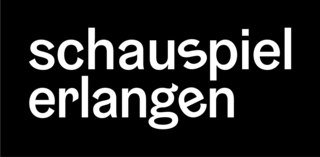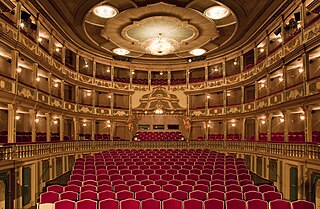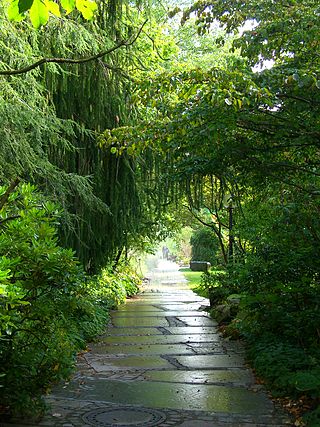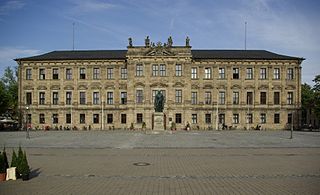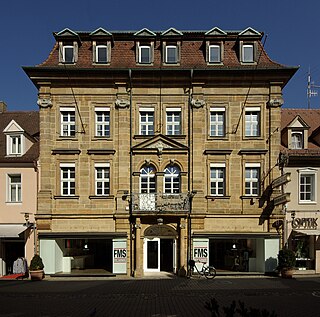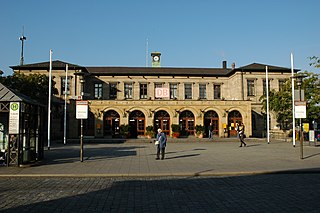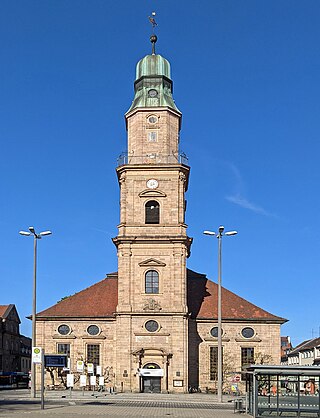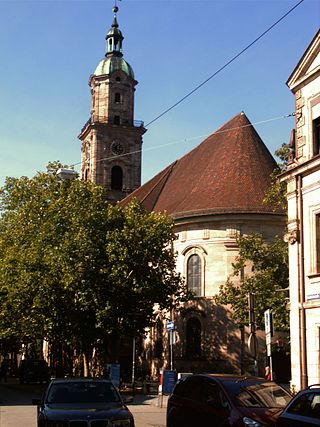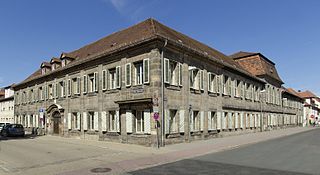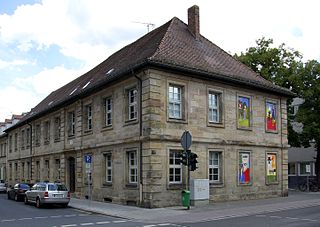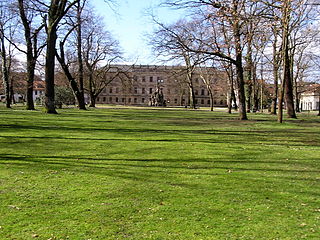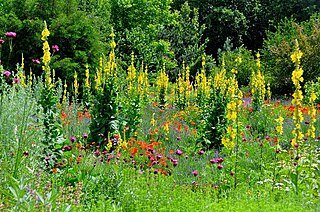Self-guided Sightseeing Tour #3 in Erlangen, Germany
Legend
Tour Facts
4.4 km
37 m
Experience Erlangen in Germany in a whole new way with our free self-guided sightseeing tour. This site not only offers you practical information and insider tips, but also a rich variety of activities and sights you shouldn't miss. Whether you love art and culture, want to explore historical sites or simply want to experience the vibrant atmosphere of a lively city - you'll find everything you need for your personal adventure here.
Individual Sights in ErlangenSight 1: Altstädter Friedhof
This list is a partial list of the List of monuments in Erlangen. The basis of the list is the Bavarian List of Monuments, which was first compiled on the basis of the Bavarian Monument Protection Act of 1 October 1973 and has since been maintained and updated by the Bavarian State Office for the Preservation of Monuments. The following information does not replace the legally binding information of the monument protection authority.
Sight 2: Altstädter Dreifaltigkeitskirche
The Old Town Church is the baroque church building of the Evangelical Lutheran congregation in the old town of Erlangen. Along with the Evangelical Lutheran Neustadt Church and the Evangelical Reformed Huguenot Church, it is one of the three large churches in Erlangen's city centre, whose towers still characterise the cityscape today.
Sight 3: Theater in der Garage
Theater Erlangen is a spoken theatre in Erlangen, Germany. The venues are the Markgrafentheater, the studio stage in the Theater in der Garage and the mobile stage in the Otokar theater bus.
Sight 4: Markgrafentheater Erlangen
Markgrafentheater Erlangen is a theater in Erlangen, Bavaria, Germany. It was opened in 1719, and celebrated its 300-year anniversary in 2019.
Sight 5: Neischl-Grotte
The Botanical Garden Erlangen is a botanical garden, which is 2 hectares in size, maintained by the University of Erlangen-Nuremberg and located on the north side of the castle garden in the city center at Loschgestraße 3, Erlangen, Franconia, Germany. It is open daily except Monday.
Sight 6: Orangerie
The Orangery of Erlangen is architecturally assigned to Erlangen Castle and is located in the palace garden belonging to the residence.
Sight 7: Schloss Erlangen
The Schloss Erlangen is a residence in Erlangen, built between 1700 and 1704 by George William, Margrave of Brandenburg-Bayreuth. Work was initially led by Antonio della Porta and after his death in 1702 by Gottfried von Gedeler. It was the first baroque building built from scratch in Franconia.
Sight 8: Markgrafendenkmal
The Schloßplatz in Erlangen, together with the neighbouring market square, forms today's centre of the city. Together, they are part of the Erlangen pedestrian zone and the venue for numerous markets and festivals.
Sight 9: Stutterheimsches Palais
The Stutterheim Palace is the most important Baroque aristocratic palace in Erlangen. It is located on the south side of the market square and was built between 1728 and 1730. Today it houses the Erlangen City Library and the Kunstpalais Erlangen.
Sight 10: Kunstpalais
The Kunstpalais Erlangen is the successor institution of the Städtische Galerie Erlangen. Since 1974, this has been located in the Palais Stutterheim, which was built between 1728 and 1730 on behalf of and for Christian Hieronymus von Stutterheim and is located in the centre of the Huguenot city. After a two-year renovation phase, the Kunstpalais was opened in 2010 with an exhibition space doubled to more than 500 m² on the ground floor and basement of the Palais Stutterheim under the founding director Claudia Emmert.
Sight 11: Besoldsches Haus
The Besoldsche Haus is a baroque aristocratic palace in Erlangen, Germany. The building with the address Hauptstraße 26 was built between 1733 and 1734 and is a listed building.
Sight 12: Bahnhof Erlangen
Erlangen station is located on the Nuremberg–Bamberg railway in the German state of Bavaria. It is the oldest railway station of the city of Erlangen and it is the only station in the city served by long-distance trains. It is classified by Deutsche Bahn as a category 3 station and has four platform tracks.
Sight 13: Hugenottenkirche
The Huguenot Church is the name given to the Evangelical Reformed Church in Erlangen. It was built between 1686 and 1693 according to the plans of Johann Moritz Richter. The construction was carried out in the course of the design of the Erlangen Neustadt, a baroque planned city. The tower dates from 1732 to 1736.
Sight 14: Neustädter Kirche
Neustädter Kirche is one of three large downtown churches of the Baroque old town of Erlangen. Germany. The church is Lutheran. It dominates the town, together with the Reformed Hugenottenkirche and the Lutheran Altstädter Kirche.
Sight 15: Egloffsteinsches Palais
The Egloffstein Palace is the largest Baroque aristocratic palace in Erlangen. The building with the addresses Friedrichstraße 17 and Südliche Stadtmauerstraße 28 was built in 1718 and today houses the adult education center of the city of Erlangen and the German-French Institute Erlangen.
Sight 16: Lynckersches Palais
The Lyncker Palace is a Baroque palace in Erlangen, Germany. The building at Friedrichstraße 35 was built in 1748 and today houses the Erlangen Singing and Music School. It is a listed building.
Sight 17: Kollegienhaus

The University of Erlangen–Nuremberg is a public research university in the cities of Erlangen and Nuremberg in Bavaria, Germany. The name Friedrich–Alexander is derived the university's first founder Friedrich, Margrave of Brandenburg-Bayreuth, and its benefactor Alexander, Margrave of Brandenburg-Ansbach.
Sight 18: Delphinbrünnlein
The castle garden in Erlangen is considered one of the first baroque gardens in Franconia. In the garden, which has been open to the general public since 1849, the largest garden festival in Europe takes place every year with the Schlossgartenfest of the Friedrich-Alexander-Universität Erlangen-Nürnberg.
Sight 19: Herz-Jesu-Kirche

The Sacred Heart Church is the oldest post-Reformation Catholic church in Erlangen. It was built from a house of prayer from 1790 in two construction phases in 1849/50 and 1895, and in 1963/66 and 2008 far-reaching changes were made to the interior and furnishings during renovation work. Since 2006, the parish, together with St. Bonifaz and St. Sebald, has belonged to the parish association Erlanger Mitte in the Erlangen deanery of the Archdiocese of Bamberg.
Sight 20: 3x9 Stolpersteine

This is a list of the Stolpersteine in Erlangen that were laid by the artist Gunter Demnig. They are intended to commemorate those victims of National Socialism who lived and worked in Erlangen.
Sight 21: Aromatic Garden
The Aroma Garden Erlangen is a public garden designed with aromatic plants at the Friedrich-Alexander-Universität Erlangen-Nürnberg. It is located in the middle of the city of Erlangen in the landscape conservation area at the Palmsanlage below the Ludwigsbrücke and the Schwabach. When the garden was opened in 1981 after two years of construction, it was the first garden of its kind in the world. Around 120 domestic and foreign aromatic plants grow on the 8,900 m² site, which form flavourings and are used as medicines, spices and cosmetic preparations.
Share
How likely are you to recommend us?
Disclaimer Please be aware of your surroundings and do not enter private property. We are not liable for any damages that occur during the tours.
GPX-Download For navigation apps and GPS devices you can download the tour as a GPX file.

